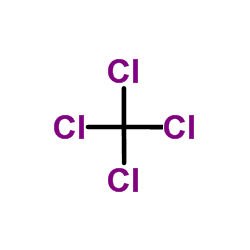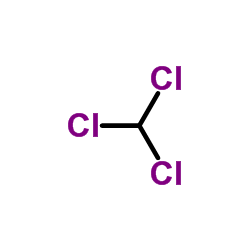2345-32-6
| Name | 4,4,4-trichlorobutanoic acid |
|---|---|
| Synonyms |
Butanoic acid,4,4,4-trichloro
4,4,4-trichloro-butyric acid 4,4,4-Trichlorobutyric acid EINECS 219-065-3 4.4.4-Trichlor-buttersaeure MFCD00100736 |
| Density | 1.551g/cm3 |
|---|---|
| Boiling Point | 274.8ºC at 760mmHg |
| Melting Point | 43ºC |
| Molecular Formula | C4H5Cl3O2 |
| Molecular Weight | 191.44000 |
| Flash Point | 120ºC |
| Exact Mass | 189.93600 |
| PSA | 37.30000 |
| LogP | 2.22140 |
| Vapour Pressure | 0.00145mmHg at 25°C |
| Index of Refraction | 1.505 |
Synonym:4,4,4-Trichlorobutyric aci Section 2 - COMPOSITION, INFORMATION ON INGREDIENTS
Risk Phrases: 20/21/22 34 Section 3 - HAZARDS IDENTIFICATION EMERGENCY OVERVIEW
Harmful by inhalation, in contact with skin and if swallowed. Causes burns. Potential Health Effects Eye: Causes eye burns. Skin: Harmful if absorbed through the skin. Causes skin burns. Ingestion: Harmful if swallowed. Causes gastrointestinal tract burns. Inhalation: Harmful if inhaled. Causes chemical burns to the respiratory tract. Chronic: Not available. Section 4 - FIRST AID MEASURES Eyes: Immediately flush eyes with plenty of water for at least 15 minutes, occasionally lifting the upper and lower eyelids. Get medical aid immediately. Skin: Get medical aid immediately. Immediately flush skin with plenty of water for at least 15 minutes while removing contaminated clothing and shoes. Ingestion: Do not induce vomiting. Get medical aid immediately. Inhalation: Get medical aid immediately. Remove from exposure and move to fresh air immediately. If not breathing, give artificial respiration. If breathing is difficult, give oxygen. Notes to Physician: Treat symptomatically and supportively. Section 5 - FIRE FIGHTING MEASURES General Information: As in any fire, wear a self-contained breathing apparatus in pressure-demand, MSHA/NIOSH (approved or equivalent), and full protective gear. Extinguishing Media: Use foam, dry chemical, or carbon dioxide. Section 6 - ACCIDENTAL RELEASE MEASURES General Information: Use proper personal protective equipment as indicated in Section 8. Spills/Leaks: Vacuum or sweep up material and place into a suitable disposal container. Section 7 - HANDLING and STORAGE Handling: Do not breathe dust, vapor, mist, or gas. Do not get in eyes, on skin, or on clothing. Use only in a chemical fume hood. Storage: Store in a cool, dry place. Store in a tightly closed container. Corrosives area. Section 8 - EXPOSURE CONTROLS, PERSONAL PROTECTION Engineering Controls: Facilities storing or utilizing this material should be equipped with an eyewash facility and a safety shower. Use adequate ventilation to keep airborne concentrations low. Exposure Limits CAS# 2345-32-6: Personal Protective Equipment Eyes: Not available. Skin: Wear appropriate protective gloves to prevent skin exposure. Clothing: Wear appropriate protective clothing to prevent skin exposure. Respirators: Follow the OSHA respirator regulations found in 29 CFR 1910.134 or European Standard EN 149. Use a NIOSH/MSHA or European Standard EN 149 approved respirator if exposure limits are exceeded or if irritation or other symptoms are experienced. Section 9 - PHYSICAL AND CHEMICAL PROPERTIES Physical State: Solid Color: white Odor: Not available. pH: Not available. Vapor Pressure: Not available. Viscosity: Not available. Boiling Point: Not available. Freezing/Melting Point: 43 - 44 deg C Autoignition Temperature: Not available. Flash Point: Not available. Explosion Limits, lower: Not available. Explosion Limits, upper: Not available. Decomposition Temperature: Solubility in water: Specific Gravity/Density: Molecular Formula: C4H5Cl3O2 Molecular Weight: 191 Section 10 - STABILITY AND REACTIVITY Chemical Stability: Not available. Conditions to Avoid: Incompatible materials. Incompatibilities with Other Materials: Oxidizing agents. Hazardous Decomposition Products: Hydrogen chloride, chlorine, carbon monoxide, carbon dioxide, acrid smoke and fumes. Hazardous Polymerization: Has not been reported Section 11 - TOXICOLOGICAL INFORMATION RTECS#: CAS# 2345-32-6 unlisted. LD50/LC50: Not available. Carcinogenicity: 4,4,4-Trichlorobutanoic acid - Not listed by ACGIH, IARC, or NTP. Section 12 - ECOLOGICAL INFORMATION Section 13 - DISPOSAL CONSIDERATIONS Dispose of in a manner consistent with federal, state, and local regulations. Section 14 - TRANSPORT INFORMATION IATA Shipping Name: CORROSIVE SOLID, ACIDIC, ORGANIC, N.O.S.* Hazard Class: 8 UN Number: 3261 Packing Group: III IMO Shipping Name: CORROSIVE SOLID, ACIDIC, ORGANIC, N.O.S. Hazard Class: 8 UN Number: 3261 Packing Group: III RID/ADR Shipping Name: CORROSIVE SOLID, ACIDIC, ORGANIC, N.O.S. Hazard Class: 8 UN Number: 3261 Packing group: III Section 15 - REGULATORY INFORMATION European/International Regulations European Labeling in Accordance with EC Directives Hazard Symbols: C Risk Phrases: R 20/21/22 Harmful by inhalation, in contact with skin and if swallowed. R 34 Causes burns. Safety Phrases: S 26 In case of contact with eyes, rinse immediately with plenty of water and seek medical advice. S 36/37/39 Wear suitable protective clothing, gloves and eye/face protection. S 45 In case of accident or if you feel unwell, seek medical advice immediately (show the label where possible). WGK (Water Danger/Protection) CAS# 2345-32-6: No information available. Canada None of the chemicals in this product are listed on the DSL/NDSL list. CAS# 2345-32-6 is not listed on Canada's Ingredient Disclosure List. US FEDERAL TSCA CAS# 2345-32-6 is not listed on the TSCA inventory. It is for research and development use only. SECTION 16 - ADDITIONAL INFORMATION N/A |
| Hazard Codes | C:Corrosive; |
|---|---|
| Risk Phrases | R20/21/22;R34 |
| Safety Phrases | S26-S36/37/39-S45 |
| RIDADR | UN 3261 |
| Packaging Group | II |
| HS Code | 2915900090 |
|
~99% 
2345-32-6 |
| Literature: Enichem S.p.A. Patent: EP1002800 A1, 2000 ; |
|
~6% 
2345-32-6 |
| Literature: Helvetica Chimica Acta, , vol. 63, # 7 p. 1947 - 1957 |
|
~% 
2345-32-6 |
| Literature: Journal of the American Chemical Society, , vol. 96, p. 2201 - 2208 |
|
~21% 
2345-32-6 |
| Literature: Chemische Berichte, , vol. 123, p. 582 - 588 |
|
~% 
2345-32-6 |
| Literature: US2680763 , ; |
|
~% 
2345-32-6 |
| Literature: Journal of the American Chemical Society, , vol. 67, p. 601 |
|
~% 
2345-32-6 |
| Literature: Chemische Berichte, , vol. 101, p. 1407 - 1413 |
| Precursor 8 | |
|---|---|
| DownStream 2 | |
| HS Code | 2915900090 |
|---|---|
| Summary | 2915900090 other saturated acyclic monocarboxylic acids and their anhydrides, halides, peroxides and peroxyacids; their halogenated, sulphonated, nitrated or nitrosated derivatives VAT:17.0% Tax rebate rate:9.0% Supervision conditions:AB(certificate of inspection for goods inward,certificate of inspection for goods outward) MFN tariff:5.5% General tariff:30.0% |








